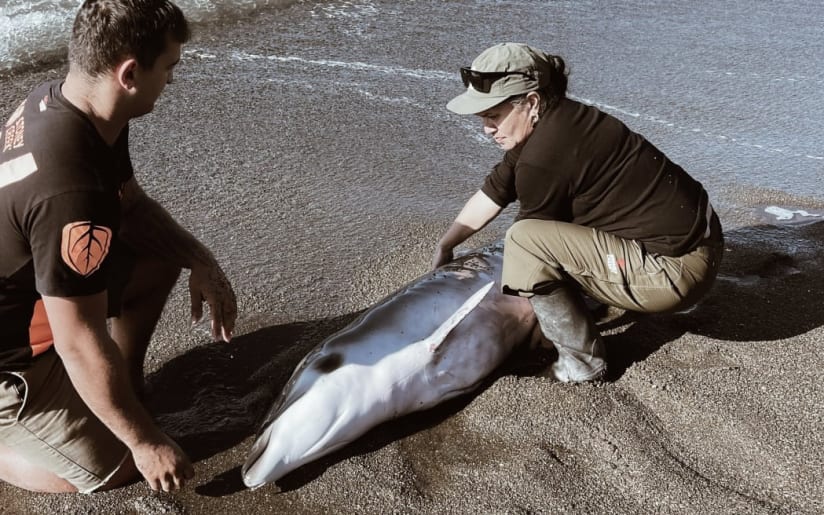by Peter de Graaf, RNZ
A baby whale that died shortly after stranding near East Cape has been identified as a species so rare it has only been seen four times before in New Zealand, and never as a new-born.
The gingko-toothed beaked whale was discovered on a beach at Te Kaha on May 18, but such is its rarity — not to mention the difficulty of distinguishing one baby whale from another — it has only now been identified through DNA analysis.
Department of Conservation marine adviser Anton van Helden said the gingko-toothed beaked whale was “exceedingly rare” and, given its habit of spending most of its time at great depths, “extremely elusive”.
The species took its name from the male’s distinctive tusked teeth, which were the shape of a gingko leaf.
Van Helden said only five, including the baby found at Te Kaha, had ever stranded in New Zealand, and this was the first neonate or new-born.
Worldwide, only about 20 had ever been recorded from strandings.
The baby whale was about two metres long but, had it survived, would have grown to about five metres and weighed two to three tonnes.
Kaimahi (workers) from Raukūmara Pae Maunga, an ecological restoration project led by Ngāti Porou and Te Whānau-ā-Apanui iwi, were among the first to spot the baby whale.
Michaela Insley said she was driving to Te Kaha with a colleague when she saw a commotion and what appeared to be a dolphin on the beach.
As they drew nearer it became clear it was some type of tohorā (whale).
They could see it was a baby because it still had creases across its body where it had been folded inside its mother before birth.
“It was a spiritual time for us because here on the East Coast, we regard the tohorā with a huge amount of respect. Our bond to the tohorā is embedded in our whakapapa and all the waiata we sing — from the time we’re at Kohanga Reo right through kura. It’s also evident in our stories and our connection to our tipuna [ancestor] Paikea,” Insley said.
It was still alive when found but died about half an hour later. The baby whale was named Wharekura, after the place it was found, then blessed and buried.
“It was like a beautiful tohu [sign]. A baby whale washing up could be telling us they are breeding again here,” Insley said.
Later, photos posted online were spotted by whale experts, who recognised Wharekura’s rarity.
A request to study the buried whale was discussed by the local hapū’s kaumātua and kuia, who allowed the tohorā to be disinterred.
“We had a kōrero about the rarity of Wharekura and about how us taking her to be studied benefits not only marine science and everybody in Aotearoa, but us as a people, too, so we can understand more about what’s happening here in our own water. Having a taonga like Wharekura washed up so young is massive for us.”
The whale was transported to the Cetacean Ecology Research Group at Massey University in Auckland, where the dissection was led by Professor Karen Stockin.
The team looked for signs of disease or injury, and contaminants such as mercury and “nasty forever chemicals” such as PFAS.
With no obvious cause of death, it had most likely died as a result of maternal separation, Stockin said.
The young whale had somehow lost its mother, on which it still depended for food.
What was clear was that the whale was very young, possibly only days old.
That was evidenced by umbilical cord remnants connected to an unhealed navel and blood vessels that were not yet fully formed.
Stockin said even beaked whale experts found it difficult to distinguish between babies of different species, so it was only confirmed as a gingko-toothed beaked whale after DNA analysis at the University of Auckland.
Van Helden said seven different species of beaked whale had now been found in the eastern Bay of Plenty.
All were mother-calf pairs, juveniles or neonates, suggesting it was an important calving area.
Beaked whales were known to frequent marine canyons and sea mounts, both of which were found off East Cape.
Wharekura was returned to Te Kaha and reburied.













0 comment
JOIN THE CONVERSATION
Read and post comments with a
Newsroom Pro subscription.
Subscribe now to start a free
28-day trial.